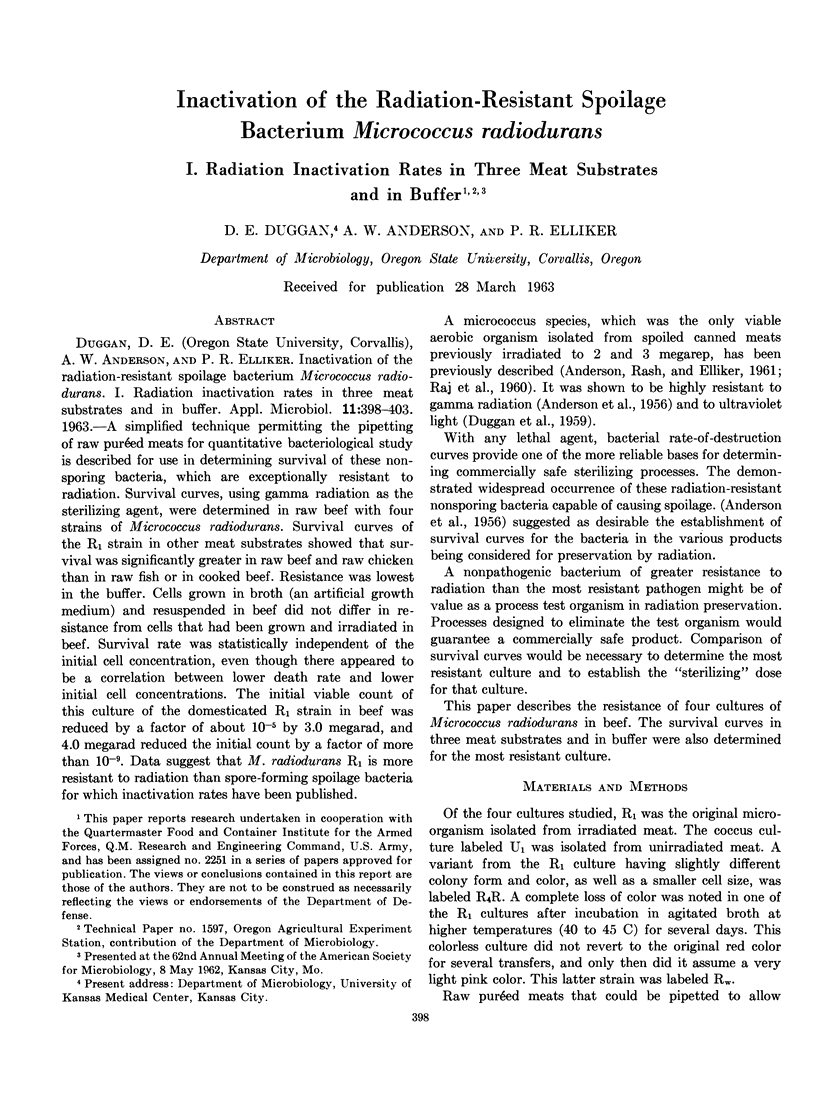Abstract
A simplified technique permitting the pipetting of raw puréed meats for quantitative bacteriological study is described for use in determining survival of these non-sporing bacteria, which are exceptionally resistant to radiation. Survival curves, using gamma radiation as the sterilizing agent, were determined in raw beef with four strains of Micrococcus radiodurans. Survival curves of the R1 strain in other meat substrates showed that survival was significantly greater in raw beef and raw chicken than in raw fish or in cooked beef. Resistance was lowest in the buffer. Cells grown in broth (an artificial growth medium) and resuspended in beef did not differ in resistance from cells that had been grown and irradiated in beef. Survival rate was statistically independent of the initial cell concentration, even though there appeared to be a correlation between lower death rate and lower initial cell concentrations. The initial viable count of this culture of the domesticated R1 strain in beef was reduced by a factor of about 10-5 by 3.0 megarad, and 4.0 megarad reduced the initial count by a factor of more than 10-9. Data suggest that M. radiodurans R1 is more resistant to radiation than spore-forming spoilage bacteria for which inactivation rates have been published.
Full text
PDF





Selected References
These references are in PubMed. This may not be the complete list of references from this article.
- DUGGAN D. E., ANDERSON A. W., ELLIKER P. R. INACTIVATION OF THE RADIATION-RESISTANT SPOILAGE BACTERIUM MICROCOCCUS RADIODURANS. II. RADIATION INACTIVATION RATES AS INFLUENCED BY MENSTRUUM TEMPERATURE, PREIRRADIATION HEAT TREATMENT, AND CERTAIN REDUCING AGENTS. Appl Microbiol. 1963 Sep;11:413–417. doi: 10.1128/am.11.5.413-417.1963. [DOI] [PMC free article] [PubMed] [Google Scholar]
- GUNTER S. E., KOHN H. I. Der Nachweis von Staphylokikken im Stuhl von Sauglingen und Kleinkindern, seine Deutung und Fehldeutung. J Bacteriol. 1956 May;71(5):571–581. doi: 10.1128/jb.71.5.571-581.1956. [DOI] [PMC free article] [PubMed] [Google Scholar]
- KELNER A., BELLAMY W. D., STAPLETON G. E., ZELLE M. R. Symposium on radiation effects on cells and bacteria. Bacteriol Rev. 1955 Mar;19(1):22–44. doi: 10.1128/br.19.1.22-44.1955. [DOI] [PMC free article] [PubMed] [Google Scholar]
- KILBURN R. E., BELLAMY W. D., TERNI S. A. Studies on a radiation-resistant pigmented Sarcina sp. Radiat Res. 1958 Aug;9(2):207–215. [PubMed] [Google Scholar]
- KOH W. Y., MOREHOUSE C. T., CHANDLER V. L. Relative resistances of micro-organisms to cathode rays. I. Nonsporeforming bacteria. Appl Microbiol. 1956 May;4(3):143–146. doi: 10.1128/am.4.3.143-146.1956. [DOI] [PMC free article] [PubMed] [Google Scholar]
- NIVEN C. F., Jr Microbiological aspects of radiation preservation of food. Annu Rev Microbiol. 1958;12:507–524. doi: 10.1146/annurev.mi.12.100158.002451. [DOI] [PubMed] [Google Scholar]
- RAJ H. D., DURYEE F. L., DEENEY A. M., WANG C. H., ANDERSON A. W., ELLIKER P. R. Utilization of carbohydrates and amino acids by Micrococcus radiodurans. Can J Microbiol. 1960 Jun;6:289–298. doi: 10.1139/m60-033. [DOI] [PubMed] [Google Scholar]


